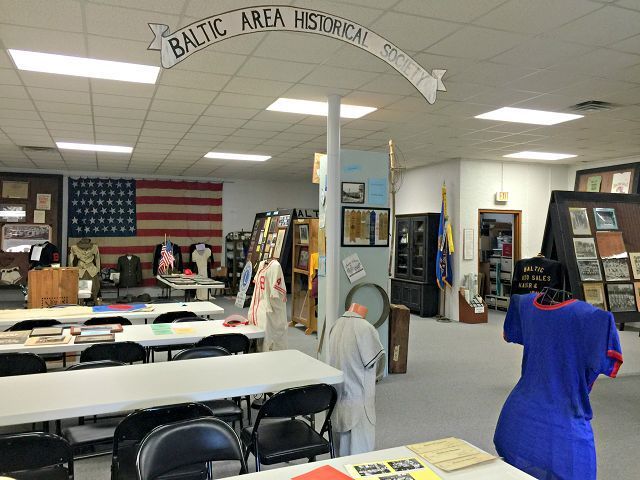Once called Buena Vista and then Rowville, today it is the village of Baltic
The first thing that you see when you walk into the Baltic Area Historical Societys museum is a large hand-sewn American flag. That was in 1910, said Don Sheetz, who is a member of the society. It was the first Homecoming.
Thats the first thing youll see but by no means all that there is to learn about Baltics history.
It all started with the pioneers in the early 1800s. Pennsylvanians, particularly Germans, began to trek westward in search of fertile land and a good supply of fresh water. Many passed through the Tuscarawas Valley, and some of those settlers decided to stay once they reached the area where Baltic now stands.
As time went on and the area became more developed, the Port Washington Road, which was the first official state route in Ohio, was built to connect Holmes County with the Erie Canal. Baltic was the mid-point on the Port Washington Road with three hotels. It was a great place for farmers and traders to spend the night on the two-day journey. Along the Port Washington Road, there were houses being established in the 1830s, Sheetz said. In 1847 they established the post office in Baltic.
That first post office was officially called Buena Vista. Sheetz said Buena Vista was named because if you go up to the schoolhouse, straight up the hill, way up on top, thats one of the highest points in the state of Ohio. Thats Buena Vista, meaning beautiful view.
As more houses, hotels and businesses came into the area, however, official organization was still lacking. In 1848 Louis Row and his wife Elizabeth bought acreage and started laying the land out into plots for the town. Interestingly each plot cost about $12 on average. With the new town laid out, it was called Rowville after Louis Row.
Of course things are never so simple as they appear. Even though the town was known as Rowville, the post office was still called Buena Vista. The problem was now that there were two towns in Ohio with this name, so the post office decided that there needed to be an official name change for the entire town.
Sheetz said, The story was that they put names in a hat and drew out the name Baltic. Now the reasoning behind that, we think, was that they were all German, and everybody knew where the Baltic Sea was or had lived close to it in Germany. It could have been the reason, but its just a guess.
So were not sure if the towns new name was actually drawn out of a hat even though it does make for a good story; however, we do know that the town was officially renamed as Baltic on Aug. 14, 1848.
The village continued to grow, and it grew further when the Wheeling and Lake Erie Railroad was completed in 1880. Residents of Baltic pledged labor, and by 1881 the first train was running. This led to Baltic officially becoming an incorporated town in 1903.
By 1910 Baltic had a population of 377, and today the population is roughly 975. This small town sits in three counties: Holmes, Coshocton and Tuscarawas. About half of Baltics population is in Tuscarawas County.
Baltic is not without its notable residents either. First among them is Dr. George Washington Crile, who grew up just down the road in Chili. Crile served in the Spanish-American War and World War I, but he is best known as one of the four founders of the Cleveland Clinic.
Baltic also was home to Jacob McQueen, an inventor who advanced the farming industry with knowledge of soil bacteria in the 1920s. He is best known for his world-famous seed inoculation. Additionally Baltic had a famous baseball player, Owen Scheetz, who played six games during 1943 for the Washington Senators, an American League team.
Today Baltic is filled with historical sites. Historical markers include Bouquets Trail and the Old Port Washington Road, and the Baltic Area Historical Society has even recreated a pioneer log cabin. Everywhere you look, youll find old buildings including some of the towns original buildings. One of those buildings is Ohios oldest flour mill, which is now beautifully preserved as the Baltic Mill Winery.
Then, of course, is the Baltic Museum, curated by the Baltic Area Historical Society. Here you can spend hours reading all about the towns history, and youll see a wide variety of historical artifacts and photographs. The Baltic Museum is located in the basement of the Baltic State Bank, and it opens every third Sunday of each month from 1-4 p.m.
There are interesting places to visit online too. Start at www.BalticHistory.org to read stories of the towns past. Then find The Baltic American on Facebook. Here youll see many wonderful historic images, and youll be able to take part in the discussion surrounding Baltics history.

